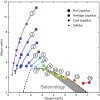Core formation and core composition from coupled geochemical and geophysical constraints
- PMID: 26392555
- PMCID: PMC4603515
- DOI: 10.1073/pnas.1505672112
Core formation and core composition from coupled geochemical and geophysical constraints
Abstract
The formation of Earth's core left behind geophysical and geochemical signatures in both the core and mantle that remain to this day. Seismology requires that the core be lighter than pure iron and therefore must contain light elements, and the geochemistry of mantle-derived rocks reveals extensive siderophile element depletion and fractionation. Both features are inherited from metal-silicate differentiation in primitive Earth and depend upon the nature of physiochemical conditions that prevailed during core formation. To date, core formation models have only attempted to address the evolution of core and mantle compositional signatures separately, rather than seeking a joint solution. Here we combine experimental petrology, geochemistry, mineral physics and seismology to constrain a range of core formation conditions that satisfy both constraints. We find that core formation occurred in a hot (liquidus) yet moderately deep magma ocean not exceeding 1,800 km depth, under redox conditions more oxidized than present-day Earth. This new scenario, at odds with the current belief that core formation occurred under reducing conditions, proposes that Earth's magma ocean started oxidized and has become reduced through time, by oxygen incorporation into the core. This core formation model produces a core that contains 2.7-5% oxygen along with 2-3.6% silicon, with densities and velocities in accord with radial seismic models, and leaves behind a silicate mantle that matches the observed mantle abundances of nickel, cobalt, chromium, and vanadium.
Keywords: core composition; core formation; earth's accretion; experimental petrology; mineral physics.
Conflict of interest statement
The authors declare no conflict of interest.
Figures


References
-
- Patterson C. Age of meteorites and the Earth. Geochim Cosmochim Acta. 1956;10(4):230–237.
-
- Connelly JN, et al. The absolute chronology and thermal processing of solids in the solar protoplanetary disk. Science. 2012;338(6107):651–655. - PubMed
-
- Bouvier A, Blichert-Toft J, Moynier F, Vervoort JD, Albarede F. Pb−Pb dating constraints on the accretion and cooling history of chondrites. Geochim Cosmochim Acta. 2007;71(6):1583–1604.
-
- Wetherill GW. Formation of the Earth. Annu Rev Earth Planet Sci. 1990;18:205–256.
-
- Rubie DC, Melosh HJ, Reid JE, Liebske C, Righter K. Mechanisms of metal-silicate equilibration in the terrestrial magma ocean. Earth Planet Sci Lett. 2003;205(3-4):239–255.
Publication types
Grants and funding
LinkOut - more resources
Full Text Sources
Other Literature Sources

